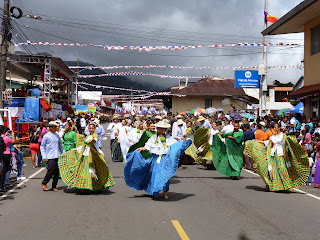Stories from Panama: Of high peaks and deep potholes
As time in Panama is flying and there
still is tons of places we haven't seen here, we decided to leave the
capital for a weekend to get some fresh mountain air. Our destination
was Boquete, a small but fairly touristy town on the foot of Panama's
highest peak, Vulcán Barú.
The plan was following:
We (three interns and one Ph.D.-student,
all working at Naos Laboratories) would rent a cheap car, start
heading towards the mountains right after work on a friday afternoon
and then arrive in Boquete late at night. We would have all saturday
and the first half of sunday before getting back in the car and
driving back to Panama city.
So Friday comes up and things start a
little different than expected. For some reason our reserved car
isn't waiting for us, so we have to deal with the whole process of
getting a vehicle all over again. And things like that can be very,
very slow in Panama. But we get it all fixed and finally end up with
a cute, tiny Kia Picanto waiting for us.
That's the first mistake we make. But you always
know it better afterwards....
At 4pm we are all ready to leave and
start driving. The mood is great and everyone is excited for a
weekend full of new experiences, delicious food and a lot of fun.
Then, after driving for quite some
time, the Picanto suddenly hits a pothole. Not the biggest surprise
on a panamanian road, but we probably choose one of the deepest
potholes you can find.
By now it is already dark outside and
we are in the middle of nowhere. We stop the car and notice that both
of our rims on the driver's side of the car are damaged. Plus the
front wheel is totally flat. The fact is, that none of us has ever
changed a tire before. But at least we have headlights with us. And
no other change than trying it.


In the trunk we find the spare tire and
all the tools we need so we start working. I don't know how long it
actually takes us, but it is way easier than I thought it would be
and after some time the Picanto is ready to go again. We start again,
slowly, with one wheel still damaged, the tiniest spare tire you can
imagine and a road which has so many holes in it that it's impossible
to avoid them. After the most stressful ride of my entire time here (and traffic in Panama is not really relaxing, believe me), we
finally find small garage that is specialized in tire repairs and is
still open although it's already after midnight.
We are happy but also a little bit
worried since (second mistake we made:), we didn't get the optional
tire and windshield insurance and have to cover all the upcoming costs by
ourselves.
But then, at the same time as Panama
has a lot of unexpected bad things to offer, there also always is the
good ones: our tires aren't damaged, only the rims are bent, fixed
within minutes and we end up paying only 10 dollars in total!
We arrive in Boquete at 2.30am. Only a couple
hours later than expected.
The rest of the weekend is simply
amazing! We find the best bakery in town (Sugar&Spice, make sure
to stop by when in town!), spent some hours at a coffee farm and
finally climb up Vulcán Barú at night to get the unique view of two
different oceans from one peak at sunrise.
I have so many unforgettable memories
of that short and sleepless weekend and there is a lot more stories
that could be told. Maybe some other time, but these pictures kinda speak for themselves:
As much as I miss winter at the moment,
I will for sure miss this crazy country, Naos Lab with all the
snails and the amazing people I got to know here! I hope I'll be back one day!






























